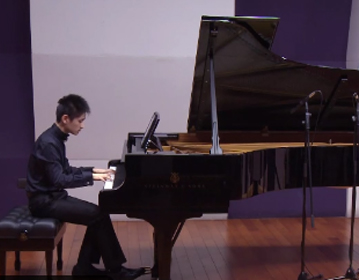Piano: Yizhe Sun
Program: Partita No. 5 in G major
Composer: J.S. Bach
Johann Sebastian Bach (1685-1750)
Praeambulum
Allemande
Corrente
Sarabande
Tempo di Menuetta
Passepied
Gigue
Partita in G major, written by Baroque composer Johann Sebastien Bach, was one of the 6 Partitas (BWV 825 – 830) that he wrote. They were created in Bach’s later life, when he was in Leipzig, after the other two set of suites, the English Suites and the French Suites. This set of suites is also the most technically demanding set, as well as the freest set in terms of structure and style. Unlike French suites, with almost every suite beginning with the Allemande, the Partitas open with Preludes, Sinfornias, Fantasies, and so on. Some of them are symphonic, others delicate.
The fifth Partita in G major is one of those delicate ones. The piece is not so symphonic as the fourth or the sixth, but still with much depth. It starts with the Praeambulum in 3 beats. A clear pattern of beats is established in this Praeambulum, and it preserved through the whole suite. The pattern is the relationship between the third beat and the first beat in the next bar. This ‘leading’ pattern is essential as it is what brings the partita together. The Praeambulum also creates the 3 beat dancing pattern, in contrast to other openings that are with more freedom (like in Partita 6). It also contains some interesting details, such as the ‘cross’ at bar 63 – 64, again showing the delicacy of the partita.
The Allemande that follows is a stately dance originated in Germany. It’s the only dance in the suite with the common time, which adds stability into the dance. However, the ‘leading’ pattern is still present, starting with the upbeat. The dialogue between the parts that started in the Praeambulum is also amplified in the Allemande. With the ornamentation, the Allemande is added with solemnity.
The style changes when we proceed into the Corrente. This is an Italian one with a fast 3/8 beat. As the French word ‘Courant’ means running, the main feeling in this dance is the fluency and the ‘leading’ pattern. The tempo is rigid with only some small exceptions. For example, in bar 23, there can be a small ritardando to indicate a transition. The ‘leading’ pattern, meanwhile, gets more emphasized in the second part, especially after bar 48.
After the flowing Corrente, the Sarabande was again peaceful and stately. Like other Sarabandes, the second beat is the stressed beat. However, in this Sarabande, the stressed second beat in one way brought the third beat and the first beat together, forming the ‘leading’ pattern. This pattern can be further enhanced with ornamentation on the third beat. The Sarabande is the slowest dance in the whole Partita, making it also one of the climaxes of the piece, as it is also the most cantabile dance.
The next dance has a very interesting name: Tempo di Minuetta rather than just Minuetta. This might be because it is not a Minuetta at all. Although the markings indicate that it is a 3 beat dance, the hemiola makes it sound like a 2 beat one. Occasionally, the 3 beat comes back, creating an interesting dialogue. Even if it’s mainly a 2 beat dance, the ‘leading’ pattern sometimes still intrudes into it, such as in bars 21-27.
The Passepied following has quite the same style as its predecessor, but a significant difference is that it has an upbeat, which also signifies the return of the ‘leading’ pattern. This pattern is very intense in this dance, almost identifiable in every bar, some emphasized with mordents. With all these, the Passepied becomes truly a prelude for the finale, the Gigue.
The Gigue is the most complex dance in the whole suite, which helps it earn its place as the finale. Like other Bach Gigues, it starts with a fugue. While other Gigues might have an accent on the third beat, in this one it is transformed to the ‘leading’ pattern, but it becomes freer, not confining itself to the 3 to 1 beats, as the Gigue itself is not a 3 beat dance. Another thing that is established in the first part of the Gigue is the importance of the fourth and fifth interval, as they build up the theme. This is also an important clue to link the first part to the next, as not like the normal Gigue with an inverted theme in the second part, this time it is developed with the two intervals. Later the original theme adds in to make it a double fugue. The whole Gigue comes to a climax at the end, with both themes present and an increase in the trills, all contributing to the complexity of the piece. Through all these, we can see the sophistication of the Partitas.


Google Yahoo Domains
Ive been following your website for 4 days now plus I should tell you I get tons benefits from your piece of writing. with now how I can get news update from your website?
Japan
Resources such as the one you mentioned right here will be incredibly useful to myself! I will publish a hyperlink to this web page on my individual blog. Im certain my site website visitors will come across that fairly beneficial.
Gatunki Szkła
Very good day, this is the really superb website, I’ve plummeting in adore studying many of the posts and threads contained after the location, sustain the nice work as well as hope to learn a lot more exciting articles from the time to come.
Leasing Finansowy
Very good points you wrote here..Great stuffI think youve made some truly interesting points.Keep up the good work.